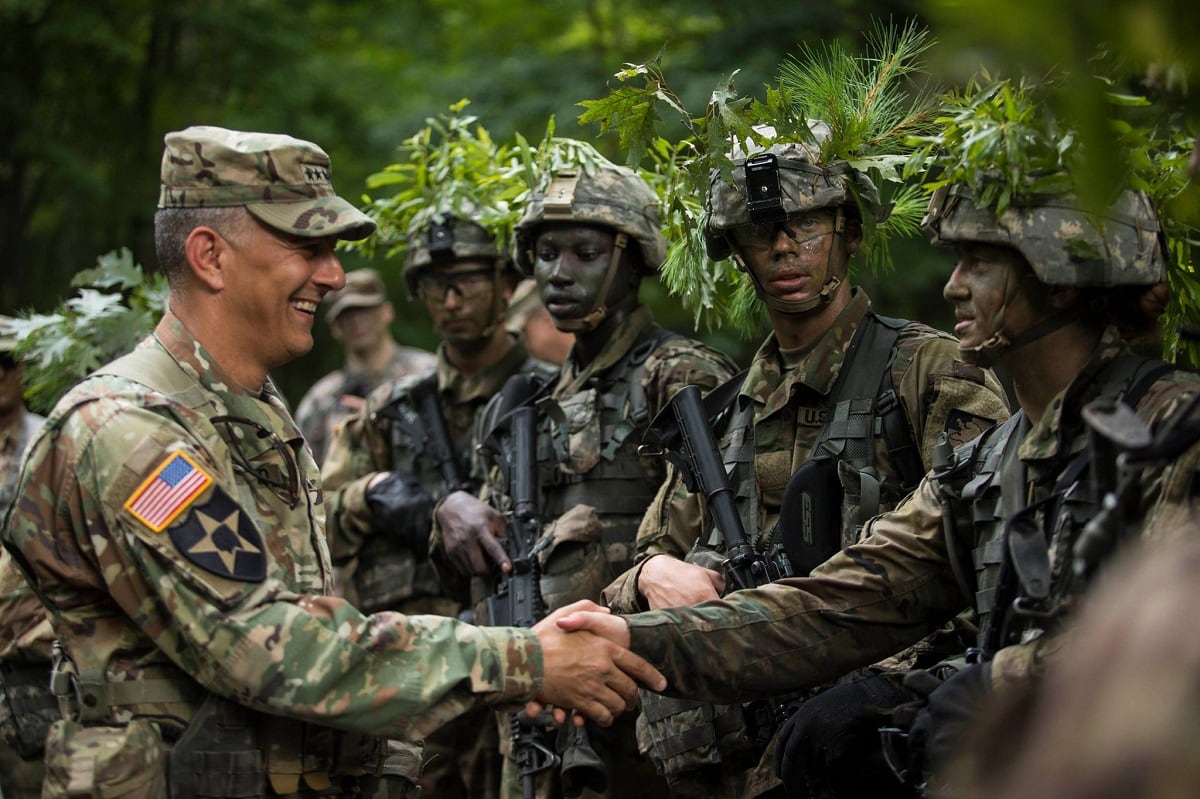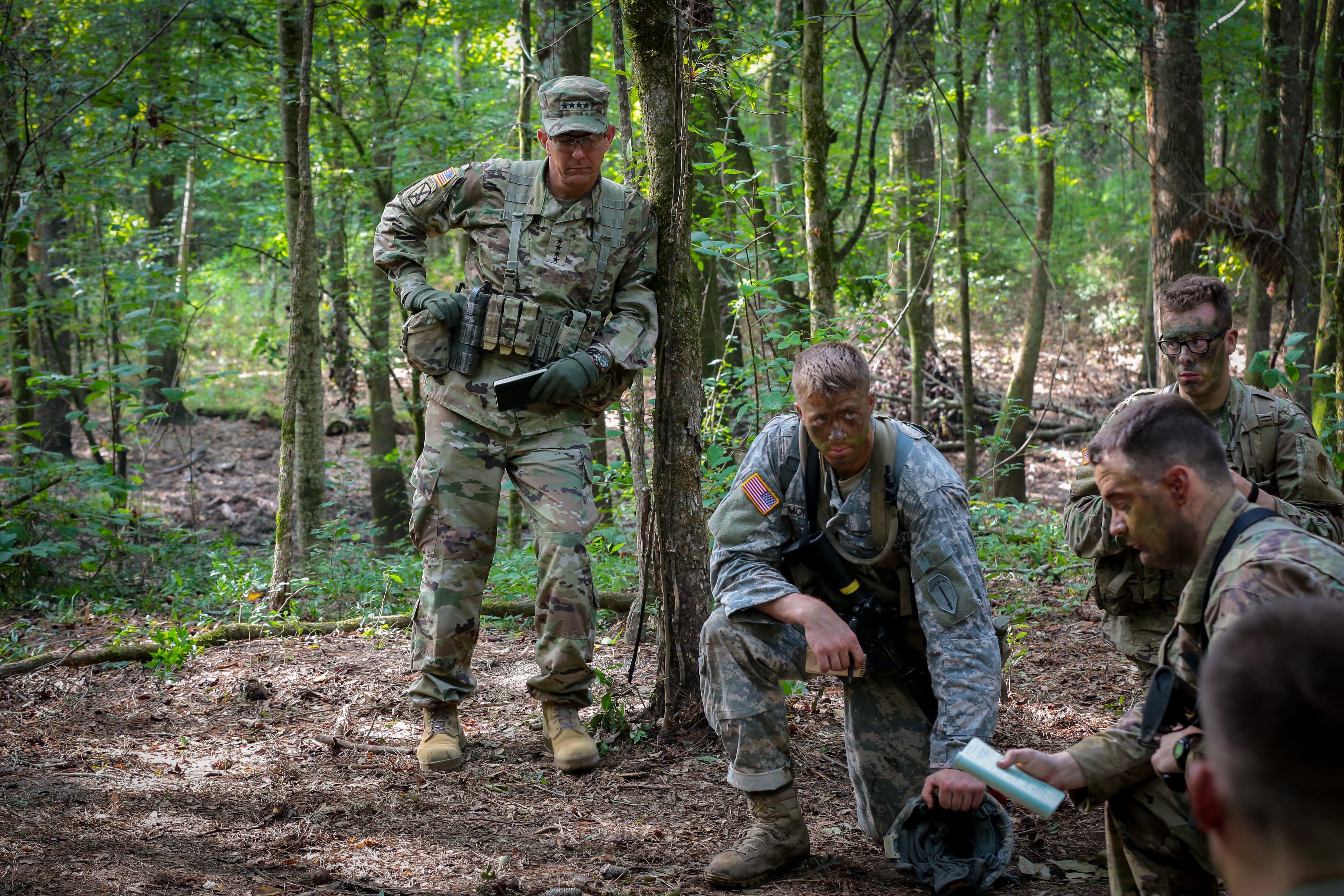An unnamed Army brigade commander has seemingly constant strikes against his units, jammed radios, enemy air attacks, indirect fires landing from what looks like every direction.
All while the battalions and companies in his formation are moving around the battlespace, returning fire, hitting enemy sensor nodes as they wade through thousands of displaced civilians in the rubble of the city they’ve patrolled.
“The pace of fighting was exceptionally fast – confusion was the norm” is the battle vignette that Col. Charles Lombardo hopes commanders will take with them when they leave a ramped-up rotation at the National Training Center at Fort Irwin, California.
RELATED

That location is one testbed for an overhaul of how Army leaders push authority down to the lowest levels of fighting units.
Gen. Stephen Townsend, head of the Army’s Training and Doctrine Command, looks at ways to reinvigorate Army doctrine on mission command and how that will fit in garrison, at training centers and on deployment in an article he co-authored with Maj. Gen. Douglas Crissman at the Maneuver Center of Excellence and Maj. Kelly McCoy, a TRADOC strategist. The article was published by the Army University Press in April.
The general spoke with Army Times about how near-peer adversaries “challenge us in all ways and the only way that we can really overcome that is leadership and mission command.”
The biggest challenge, he said, is at low-level unit training and garrison operations.
“There’s too much top down direction, too much philosophy of compliance in mission command,” Townsend said.
The effort is being spread across the Army, permeating beyond just combat training.
"We continue to analyze the right level of instruction devoted to mission command throughout a leader’s professional military education,” Col. Ken Hawley, director of policy and plans at Army University, told Army Times.
The university recently adjusted the Noncommissioned Officers Education System and the Captains Career Course common core, updated the Advanced Operations Course to the Command and General Staff College, increased emphasis at Pre-Command Course, and revised the Tactical Pre-Command Course to place greater emphasis on the commander’s role in mission command, he said.
Some of that is happening through what Townsend described as “tweaks” to doctrine such as reinserting the term “command and control” rather than using “mission command” as a catch-all.
“We used the same words to mean too many different things and confusion resulted. The uniqueness and importance of our approach to command and control was lost,” he wrote.
That’s why this year TRADOC will update its doctrine in a revised ADP 6-0, “Mission Command: Command and Control of Army Forces.”
Looking back to an earlier time in his career, Townsend said that when he was a company commander he answered to one person – the battalion commander.
Even if the battalion S4 called own and said they wanted an equipment inventory done because the division G4 is calling for this, it didn’t necessarily change his schedule.
“That’s nice to know but it’s not on my training calendar this week so I’ll get to it when I get to it,” Townsend said.
And his battalion commander supported adhering to that schedule.
A basic change is for higher-level leaders, especially at the general level and above, to stop filling the schedules of their subordinates for them.
Townsend wants to see unit leaders filling their own “white space” on a schedule.
Some of that was necessary as the Army had to free up manpower for recent wars and create “turnkey training” where a cookie cutter approach was used and a whole support system put in place to feed, clothe, house and model training as a unit pushed out the door to combat.
“They go through this hamster wheel, then they’re ready for their next deployment,” Townsend said. “We sort of forgot how much leader development is deciding what to do for yourself.”
Now commanders will need to figure out a lot of that on their own and be as expeditionary as possible in their thinking, training and behaviors.
The simplest version of it is to push aside the non-combat essentials such as giving commanders the discretion for whether to conduct safety briefings or instead use valuable time in the day for combat specific training.
That emerged from Army Secretary Mark Esper’s memo that removed many of the mandatory, non-combat training requirements.
But as Townsend talked to troop and battery level commanders in the field, he soon learned that what’s said and what’s believed can be vastly different.
“They didn’t believe it,” Townsend said.
The response he got was that leaders at those levels and lower knew what mission command was, taking decisive action and prudent risk, but they didn’t really buy it when they were being told to execute it.
And a lot of that will flow from the combat training centers such as NTC and the Joint Readiness Training Center at Fort Polk, Louisiana, Townsend said.
“We’re going to expect more from our CTCs, which will backwards evolve and affect home station training,” he said.
Much of that is simplifying how commanders issue orders.
The general said much of the time a commander should just issue an operations order and let their subordinates go from there.
“Provide just enough information but not too much,” he said. “Just enough direction but not too much.”
He has a vision for how that home station training works. If the battalion is headed to the field for two weeks, then at least three days of that exercise should be devoted to squad training. The squad leaders brief the platoon and company commanders on what they need, and that gets resourced and executed.
“You’ll see the higher-level events will be better,” Townsend said.
The four-star has seen improvement in the past two to four years, especially at the combat training centers.
“Our sparring partner is bigger and badder than they’ve ever been,” Townsend said.
And at his level, Lombardo is seeing the effects of changes on both ends.
They’ve seen units be able to jump a brigade combat team’s battalion command post 90 to 120 times in a rotation. And cut down that jump time from 18 hours down to just over three hours.
That’s largely a function of having each of the 10 battalions in a BCT rotation jumping their command post every other day for weeks on end.
Some of that is shrinking down to the essentials. Instead of three computer screens, use one. Make a three- day supply fit on one truck where in the past a tactical operations center took multiple busloads of gear to stand up, he said.
Todd South has written about crime, courts, government and the military for multiple publications since 2004 and was named a 2014 Pulitzer finalist for a co-written project on witness intimidation. Todd is a Marine veteran of the Iraq War.





